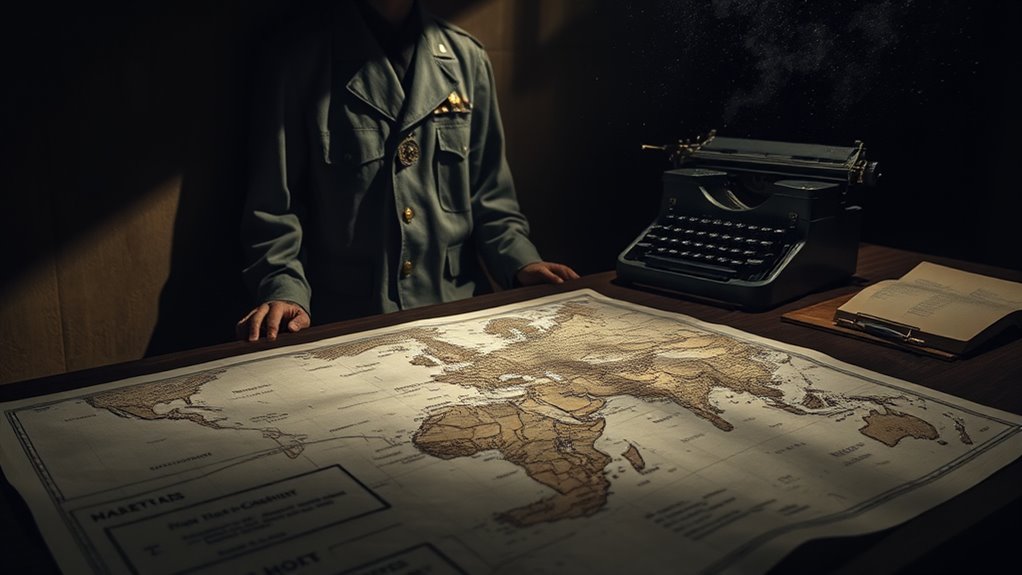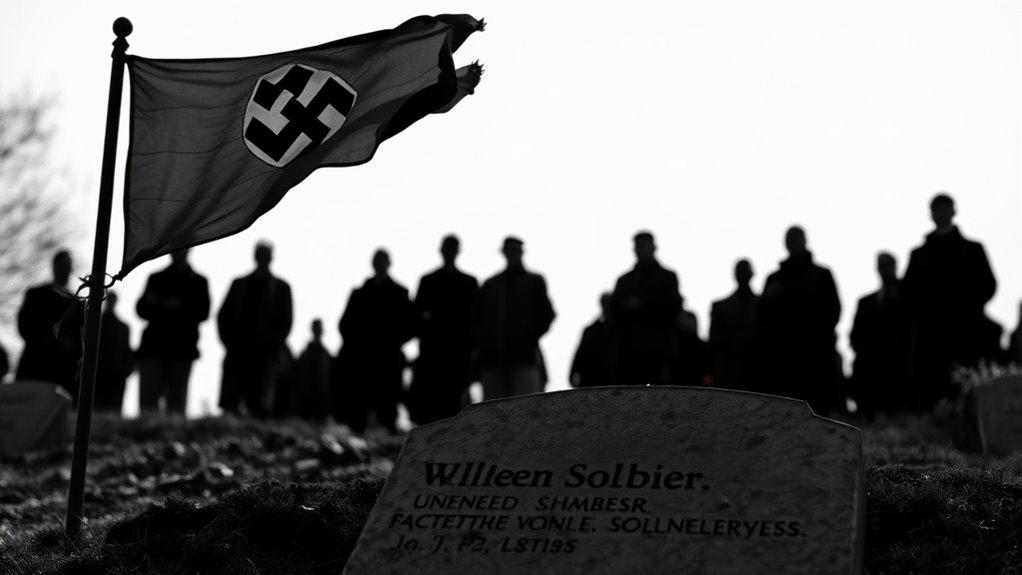The story of Glyndwr Michael, the dead man who tricked the Third Reich, is both fascinating and chilling. In 1943, British intelligence transformed his corpse into Major William Martin as part of Operation Mincemeat, misleading the Nazis into believing an invasion of Greece was imminent. This clever ruse diverted 90,000 German troops and greatly impacted the Allied invasion of Sicily. This audacious deception crafted a new chapter in warfare, and there’s much more to uncover about its consequences.
Key Takeaways
- Glyndwr Michael’s body was transformed into Major William Martin to mislead the Nazis about Allied invasion plans during World War II.
- A briefcase attached to Michael’s body contained fabricated documents that convinced German intelligence of an impending invasion of Greece instead of Sicily.
- The operation, known as Operation Mincemeat, successfully diverted a significant German panzer division to Greece, reducing resistance in Sicily.
- The deception played a crucial role in the Allies’ swift capture of Sicily, contributing to the downfall of Mussolini’s regime.
- Operation Mincemeat remains a landmark example of successful military deception, influencing intelligence tactics and ethical discussions in modern warfare.
The Setup of Operation Mincemeat

When Glyndwr Michael died in January 1943, intelligence officers saw an opportunity to turn his tragic fate into a critical weapon against the Nazis. They created Operation Mincemeat, crafting a detailed backstory for him as Major William Martin. His identity included personal items that lent credibility to the ruse.
For three months, his body was preserved in Hackney Mortuary, while officers Charles Cholmondeley and Ewen Montagu meticulously planned the deception. The aim was to mislead the Nazis into thinking the Allies would invade Greece instead of Sicily.
When his body was shipped to southern Spain and discovered near Huelva, the attached briefcase contained a letter marked “PERSONAL AND MOST SECRET,” setting the stage for a masterful misinformation campaign.
Execution of the Plan

With the groundwork laid, the execution of Operation Mincemeat unfolded with precision.
The body of Glyndwr Michael, under the alias Major William Martin, was shipped to southern Spain and discovered near Huelva. Local authorities mistakenly identified him as a British military courier, lending credibility to the operation.
Attached to his corpse was a briefcase containing a letter marked “PERSONAL AND MOST SECRET,” a critical piece of evidence. Spanish officials buried him with military honors, further legitimizing the ruse.
The success hinged on convincing Nazi agent Adolf Clauss to pass the fabricated information up the chain to Adolf Hitler. This deception led to the relocation of a panzer division of 90,000 soldiers to Greece, paving the way for the Allied invasion of Sicily.
Intelligence and Deception

Intelligence and deception played crucial roles in shaping the course of World War II, as the Allies sought innovative ways to outsmart their adversaries.
One of the most remarkable examples is Operation Mincemeat. British intelligence cleverly planted false information on Glyndwr Michael’s body, disguised as Major William Martin, to mislead the Nazis about invasion plans.
Operation Mincemeat showcased British intelligence’s ingenuity in deceiving the Nazis by planting false invasion plans on a disguised corpse.
By utilizing decrypted German communications from Bletchley Park, they enhanced the operation’s credibility. A briefcase marked “PERSONAL AND MOST SECRET” convinced Nazi agent Adolf Clauss to relay the misinformation.
This operation exemplified a broader strategy of intelligence deception, showcasing how the Allies created fictitious double agents to confuse and divert enemy forces, ultimately leading to significant advantages during the war.
Impact on the War

Though often overlooked, the impact of Operation Mincemeat on the course of World War II was profound.
By successfully misleading the Germans into relocating a panzer division of 90,000 soldiers to Greece, the operation diverted essential resources away from Sicily. When the Allies invaded Sicily on July 9, 1943, they faced considerably fewer casualties than expected, leading to the island’s swift capture.
This victory played a pivotal role in the downfall of Benito Mussolini, shifting the war’s dynamics in favor of the Allies. Operation Mincemeat showcased the effectiveness of creative strategies, forcing Germany onto the defensive and altering their strategic planning.
Ultimately, it markedly shifted the momentum of World War II, demonstrating the power of intelligence deception in warfare.
Legacy and Modern Implications

As historians and military strategists reflect on Operation Mincemeat, its legacy continues to resonate through both popular culture and contemporary intelligence practices.
The success of this operation inspired films like “The Man Who Never Was,” showcasing the fascination with military deception. Today, tactics from Mincemeat, such as crafting elaborate identities, influence modern espionage, emphasizing the psychological aspects of intelligence work.
The legacy of Operation Mincemeat continues to inspire modern espionage through its innovative use of deception and psychological strategy.
Furthermore, ethical discussions around deception have evolved, with a focus on the moral implications of manipulating information.
The creativity and strategic planning displayed in Mincemeat set a precedent for ongoing studies in deception warfare, reminding us that the legacy of this operation extends beyond the battlefield, shaping how we perceive and navigate the complexities of espionage today.
Background and Family Life of Glyndwr Michael

Glyndwr Michael’s early life was marked by hardship and instability, shaping the man he’d become. Born in 1909 in Abba by Goetre, South Wales, he grew up in a troubled household.
His father, Thomas, a coal miner, struggled with mental health issues, forcing the family into a workhouse due to poverty. This instability and the stigma of illegitimacy left Glyndwr feeling inferior and socially isolated.
The environment around him was harsh, riddled with child abuse and mental illness, reflecting the socioeconomic struggles of the time.
Later, as an adult, he’d find himself in a different world, even spending time in southern Spain, where he’d contemplate life in an abandoned warehouse, far from his troubled beginnings.
Community Impact and Call to Action

Glyndwr Michael’s story reminds us of the urgent need to support homeless individuals in our communities.
By raising awareness and fostering empathy, we can inspire initiatives that make a real difference in their lives.
Let’s take action—whether through volunteering, donating, or simply starting conversations about homelessness, every effort counts.
Supporting Homeless Individuals
While many may not realize it, the story of those who find themselves homeless often stems from deep socioeconomic struggles that can affect anyone. Supporting homeless individuals requires community initiatives that offer critical services like mental health care and job training. Additionally, understanding the key domains of development in psychology can help us address the underlying issues that contribute to homelessness.
You can make a difference by engaging in local volunteering efforts, such as food banks and shelters. These actions provide immediate aid and foster a sense of belonging.
Additionally, consider donating to organizations that offer housing assistance and rehabilitation programs, which are essential for improving lives.
Promoting Community Awareness
Homelessness affects individuals from all walks of life, and raising awareness is key to fostering a supportive community.
By understanding the systemic issues that contribute to homelessness, you can help create a culture of empathy and compassion.
Get involved in local initiatives aimed at assisting homeless individuals—your time and resources can make a significant impact.
Volunteering or donating can’t only provide immediate relief but also reduce stigma surrounding homelessness.
Encourage discussions in your community about how to collaboratively address these challenges.
Supporting organizations that offer resources and services for the homeless leads to positive outcomes for everyone.
Together, we can cultivate a community that uplifts those in need and champions change for a better tomorrow.
Frequently Asked Questions
How Accurate Is the Film the Man Who Never Was?
Did you know that Operation Mincemeat contributed to a 10,000 casualty reduction in the Allied invasion of Sicily?
The film “The Man Who Never Was” captures the essence of this clever deception but takes creative liberties. While it dramatizes certain events and focuses on Ewen Montagu’s role, it simplifies aspects of Glyndwr Michael’s life.
Despite these embellishments, the film effectively highlights the ingenuity behind military deception during WWII, making it historically significant.
How True Is Operation Mincemeat Film?
The film “Operation Mincemeat” captures the essence of the true story, but it takes some creative liberties.
You’ll see the meticulous planning by intelligence officers and the use of Glyndwr Michael’s body, reflecting real events.
However, it simplifies complex historical nuances for drama.
While it pays tribute to the individuals involved, you should remember that some details might be altered or dramatized for entertainment purposes.
Who Defeated the 3rd Reich?
You can say the Allies defeated the Third Reich through a combination of military might and strategic deception.
The British and American forces, along with their allies, launched coordinated attacks, including the pivotal D-Day invasion. They utilized intelligence operations, like decrypting enemy communications, to gain an advantage.
Was Jean’s Real Operation Mincemeat?
In the world of wartime wonders, Operation Mincemeat was a masterful maneuver, but Jean’s real involvement isn’t as straightforward.
While Mincemeat cleverly misled the Nazis, you’ll find that Jean’s contributions, if any, were likely less prominent.
The operation primarily spotlighted the skillful strategies of British intelligence officers.
Conclusion
In the end, Glyndwr Michael’s remarkable story showcases the power of deception in warfare. His sacrifice played a vital role in Operation Mincemeat, which misled the Nazis and contributed to the Allies’ success in the Mediterranean. Did you know that this elaborate ruse led to the Allies successfully landing in Sicily, resulting in a 38% reduction in Axis forces? Michael’s legacy reminds us that even the most unexpected heroes can change the course of history.








